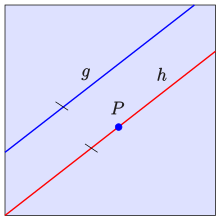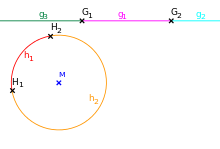Parallel postulate
The parallel axiom is a much discussed axiom of Euclidean geometry. In a frequently used formulation dating back to John Playfair, it states:
"In a plane α
for every straight line
and every point
outside
exactly one straight line that
is parallel to and
passes through the point "
"Parallel" means that the straight lines lie in a plane but do not have a common point.
This uniquely determined straight line is called the parallel to 

In the Elements of Euclid, this sentence is found as the fifth postulate (parallel postulate) in the following formulation: "Required shall be: … that if a straight line [ 









In modern formulation this means that for every straight line 



The naming of the parallel postulate varies in the literature. It is often called the Fifth Postulate of Euclid (Elements, Book 1), but sometimes it was also called the 11th Axiom or the 13th Axiom.

Parallel axiom

Intersection S of h and k if α+β<180°.
History
This postulate clearly stands out from the other postulates and axioms due to its length and complexity. It was perceived as a flaw (unsightly feature) in Euclid's theory even in ancient times. Again and again there were attempts to derive it from the others and thus to show that it was dispensable for the definition of Euclidean geometry. Historically, this task is known as the parallel problem and remained unsolved for over 2000 years. Unsuccessful attempts were made, for example, by
|
Carl Friedrich Gauss was the first to recognise that the parallel problem is fundamentally unsolvable; however, he did not publish his findings. He did, however, correspond with various mathematicians who pursued similar ideas (Friedrich Ludwig Wachter, Franz Taurinus, Wolfgang Bolyai).
Equivalent formulations
A number of statements were also found that are equivalent to the Euclidean parallel postulate under the condition of the remaining axioms of plane Euclidean geometry. The underlying axioms are the plane incidence axioms (I.1 to I.3), the axioms of arrangement (group II), the axioms of congruence (group III) and the axioms of continuity (V.1 and V.2) in Hilbert's axiom system of Euclidean geometry:
- "The sum of the angles in the triangle is two rights (180°)." (cf. Giovanni Girolamo Saccheri)
- "There are rectangles."
- "For every triangle there is a similar triangle of any size". (John Wallis).
- "Step angles at parallels are equal".
- "Through a point inside an angle there is always a straight line that intersects the two legs."
- "Through three points not lying on a straight line there is a circle". (Farkas Wolfgang Bolyai)
- "Three points that lie on one and the same side of a straight line and have congruent distances to this straight line always lie on a common straight line."
Non-Euclidean Geometry
In 1826, Nikolai Lobachevsky was the first to present a new type of geometry in which all the other axioms of Euclidean geometry apply, but not the parallel axiom, Lobachevskian or hyperbolic geometry. This proved that the parallel axiom could not be derived from the other axioms of Euclidean geometry.
János Bolyai independently arrived at similar results almost simultaneously.
This led to the development of non-Euclidean geometries, in which the postulate was either completely deleted or replaced by others. In some cases, non-Euclidean geometries also violate other axioms of Euclidean geometry besides the parallel axiom.
Elliptic parallel axiom
Thus, in an elliptical plane it is not possible for Hilbert's arrangement axioms (group II) and the congruence axioms for distances (III.1, III.2 and III.3) to be fulfilled at the same time. Here, in the sense of congruence, one can "sensibly" only introduce an arrangement ("separation relation" through four instead of three points in the case of a Hilbertian intermediate relation) as for projective planes, because elliptical planes in the sense of metric absolute geometry are also projective planes, their "elliptical" (actually projective) parallel axiom is simply: "There are no non-intersections, two different straight lines of the plane always intersect at exactly one point" see Elliptical Geometry#Marking.
The figure at the top right illustrates the difference between an arrangement on an affine straight line 









The situation is different on an affine circle and a projective straight line. Two points divide the affine circle line into two arcs. Affinities of the plane that map 




The circle line can be understood as a model of a projective straight line over an arranged body 











Note that also in the case of the straight line 




Hyperbolic parallel axiom according to Hilbert
In 1903 David Hilbert gave the following formulation for a parallel axiom of hyperbolic geometry, compare also the figure on the right:
If 







The angle space 


In Hilbert's axiom system mentioned above, one can replace the Euclidean parallel axiom (IV by Hilbert) with Hilbert's hyperbolic parallel axiom. Thus one obtains (for the plane to which Hilbert restricts himself here, i.e. of the group of incidence axioms only I.1 to I.3 are needed) a contradiction-free axiom system for which there is exactly one model (except for isomorphism): The real, hyperbolic plane, which can be modelled, for example, by the (real) Klein circular disk model within the real Euclidean plane. He outlines the proof himself in his Fundamentals. A complete proof was given by Johannes Hjelmslev in 1907.

On the difference between affine and projective arrangement.

Hilbert's hyperbolic parallel axiom in Klein's circular disk model of (real) hyperbolic geometry. The formulation of Hilbert's axiom with half-straights presupposes an arrangement of the hyperbolic plane in the sense of Hilbert's axioms. Note that only the points inside the circle line (grey) are points of the hyperbolic plane.
Questions and Answers
Q: What is the parallel postulate in geometry?
A: The parallel postulate in geometry is one of the axioms of Euclidean geometry, stating that if you cut a line segment with two lines, and the two interior angles the lines form add up to less than 180°, then the two lines will eventually meet if you extend them long enough.
Q: Why is the parallel postulate sometimes called Euclid's fifth postulate?
A: The parallel postulate is sometimes called Euclid's fifth postulate because it is the fifth postulate in Euclid's Elements.
Q: What is the field of geometry that follows all of Euclid's axioms called?
A: The field of geometry that follows all of Euclid's axioms is called Euclidean geometry.
Q: What are geometries that do not follow all of Euclid's axioms called?
A: Geometries that do not follow all of Euclid's axioms are called non-Euclidean geometry.
Q: What happens if the two interior angles formed by two lines add up to more than 180°?
A: If the two interior angles formed by two lines add up to more than 180°, the two lines will never meet no matter how long they are extended.
Q: What is Euclidean geometry?
A: Euclidean geometry is the field of geometry that follows all of Euclid's axioms.
Q: What is non-Euclidean geometry?
A: Non-Euclidean geometry is the field of geometry that does not follow all of Euclid's axioms.
Search within the encyclopedia